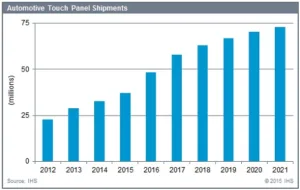Demand for touch screen automotive displays is rising rapidly, due to the widespread adoption of consumer devices such as smartphones and tablets. IHS predicts a CAGR of 18% through 2018 for automotive touch panel shipments – including shipments of both factory-installed systems and aftermarket applications. Revenues are expected to reach $1.5 billion at this time.
Touch technology improvements are also changing automotive touch use. The market has been dominated by analogue resistive touch for years, which can be operated while wearing gloves and is resistant to noise. However, touch screens requiring lighter touches are quickly becoming standard in many cars, affecting the transition from resistive to procap touch. Adoption, which has been under discussion since 2012, is expected to begin this year.
Improvements in the consumer interface will see most automotive touch panels in 2017 use procap technology – surpassing resistive touch. However, some manufacturers will stick with resistive touch to reduce costs and avoid issues in the procap supply chain.
IHS also notes that the use of in-car displays is changing, to favour entertainment as well as information. There is a growing need for displays using irregular or curved shapes, larger sizes and higher resolutions, said IHS’ Shoko Oi.

